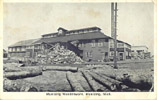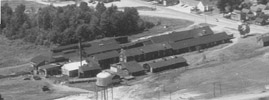
Munising Wood Products
Information and links related to the Munising Wood Products
factory that operated in Munising, Michigan from 1911 to 1955.

Interview Notes: Bill Boucha, Walt Corey, and Carl Larson
Bill Boucha started in 1933 as a helper in the clothespin department under Al Frederickson. The first 3 years were split between clothespins and payroll work. Coming back in 1940, he had a year on the log pond, then joined Howard Norton in 1941 on payroll and costs. After ? years of school, went to the Marquette plant as a (unreadable), coming back to Munising in charge of payroll, costs and personnel in 1947.
He began working at the mill in 1933 when Elmer Erickson was manager. The government's new regulations limiting the number of hours an employee could work had just come into effect, so he remembers that a lot of new men and women were hired about 1933. There were two shifts a day, one 7AM to 3PM and one 3PM to 11PM. There was no pension plan or insurance plan for laborers but salaried employees had a group insurance plan and a small non-transferable pension if they stayed with the company.
While Walt Corey remembers the early years of Elmer Erickson's term as manager, Bill recalls the later years when he had much experience and was an efficient manager. Bill said of the employees, "One thing that was characteristic of the woodenware was that it was like a big family. People knew each other by the first name, though there were 200-300 employees during the war, for instance."
Bill recalls that the plant made 50 million tent stakes out of hardwood during World War II for the army.
"The depression was very tough", Bill remarked.
Together, Bill and Walt related how the woodenware plant looked. It was a complex of wood frame buildings, eight or even more in number, set on a large piece of land bordered by the LS&I railroad tracks and Cedar St in Munising. The office stood where Hub's Super Valu store (now the Munising Credit Union) is today. The manager had a separate room off to the side of the main office and Walt's storeroom was behind that. The front door of the office faced Cedar St.
From maps that the two men drew, three main warehouse-sized buildings stretched back toward the Anna River from Cedar St. At the farthest east end, a log pond was located next to the huge decks of logs stacked waiting to be used. In the early days, the logs came in by horse teams, later in the 1920's logging trucks were used.
Logs had to be steamed in a "hot pond" that measured 25 by 100 feet and looked like a huge swimming pool. It was dug out of the ground, (several unreadable words) floor and sides that had steam pipes imbedded in them. The water was six feet deep and very hot. In winter, it steamed all the time. Frozen logs decked next to the pool needed at least an hour or two to soak but it took less time in the summer. A man fell into a pool once at the veneer mill, it was similar to the woodenware's pool, and as Walt described it, "it cooked him"!
A man with a peavy worked between the decked logs and the hot pond all day long and as fast as one log was hauled into the mill, he'd roll another one in to replace it. That went on all day long, at a steady pace, Bill and Walt said. At the mill end of the hot pond, a motorized chain was attached to each log by a man (nimble) who had to keep the flow of wood going into the sawmill.
At the sawmill, some of the bark was removed and in a separate little building nearby (just north) it was burned in the power plant. Bark was thrown into a fire under the steam boiler from 1908 to 1923, Walt said. In 1923 the mill had a big electric generating plant installed in that building.
When the log came into the sawmill, there was a sawyer who judged each log with an experienced eye as it came in. It was up to him to read just what pieces could be cut from that particular log. He set the saw blade, ordering his helper on the other side of the six foot diameter circular saw blade how to set the cut. The saws were used so hard that there was a separate filing room with a full-time filer whose only job it was to sharpen the alternate blades that weren't in use at the time. That file shop was near the sawmill, off to the east end of the two-story mill.
A conveyor belt took the pieces that the sawyer and his saw had cut to the next department where an edgermen took the rough boards and cut the optimum wood out of each piece. His saw blades were filed regularly also.
Next, a trimmer sent the appropriately-sized pieces of wood, now in more manageable sizes, to the different departments. They went to such departments as clothespins, rolling pins, plates, bowls, etc. Much of it went to the drying kiln that was in a separate building, but not the bowl wood.
"Once a piece was dried you could hardly turn it on a lathe", Bill said. So the bowls were turned while green and dried later.
To describe the room overall and how it looked, how it was to work in, (an unreadable line). Bill said the part that was two stories tall had huge drive belts hanging down from the ceiling which drove the different machines. The room had lots of windows so it was light, but it was very noisy and the dust was so thick at times it was a real problem. The company worked years on trying to find a solution to that dust problem. It did get better as the years went on.
The bowl shed was not two stories tall, but had a loft upstairs for drying the completed bowls.
Off to the side of this first building, which housed the saws, bowl turning lathes and clothespin department there were two smaller areas on the south side of the building. One was for a machine shop and the other was for grinders. The machine shop made parts for all the equipment -- things were always wearing out under such heavy use, Bill said.
The bowl-turning lathes were treacherous machines, Bill said. A big, heavy, solid piece of hardwood had to be manhandled up to the turning screw. It took a big strong man to lift those blocks up. They worked in pairs on these machines. The "back" man lifted the block, loaded it on the turning screw and got out of the way. The "front" man then guided the knife around the block and took off the outer shell with any bark remaining which made a surface that became the outer surface of the biggest bowl. The adjustable lathe produced all the sizes of bowl on the same machine--each successively smaller bowl was scooped out on this turning screw.
As the lathes turned, especially on this first cut, a "skull" came off of the block and this could be dangerous if the skull broke in all directions. The back man had to be ready to move fast if that happened.
These men were paid by piecework--they got very fast.
The second cut would create the biggest bowl that a particular block could produce. It was about 5/8 inch thick as it turned off the lathe and was caught before hitting the ground by the back man. He set it aside and watched for the second bowl to drop. By the time the bowls were sanded by one of about 10 sanders all working in a long row in another building, and was dried, it was down to it's sales thickness of about 1/2 inch, Bill said.
Just before the bowl took the final turn, controlled by the front man, off the lathe, the back man sliced the bottom off flat in one stroke. Imagine the sharpness of the blades!
The lathe had a wicked-looking curved blade the shape of a bowl that produced the inside cuts on all but the first bowl.
Munising woodenware bowls, especially, became famous and were shipped all over the world. Sometime in the 1930's they were branded with a special mark on the bottom. (This could have been in the latter 1920's due to the clues I have found- Ken Graber comment)
Bill also described two other major buildings that were on the mill grounds, not quite as far back on the property as the log pond or the sawmill buildings, but nearer the office. First, near the LS&I railroad spur was a warehouse and shipping department. This included a loading dock and storage of products ready to go out.
Second, to the south of that shipping department was a separate building, also two stories tall, given entirely to bowl-making and finishing. Between the two buildings there was a walkway of wooden planks that raised and lowered like a drawbridge, half on each side of the alley so that horse-drawn waqons could be driven up to the door. Walt said he remembers being in such good shape he could jump the distance between the two--he reckoned about 10 feet. In the bowl finishing building was a carving department, a lacquer booth for painting, drying rooms and other work areas. Bill recalls that about 10 people would be busy sanding bowls on either disc or belt sanders in the main part of the room.
Also attached to this bowl finishing warehouse was the clock room and time office where Bill Boucha was in charge of records, pay, etc. He sent the information to Marquette and the checks came in every other Friday to workers.

